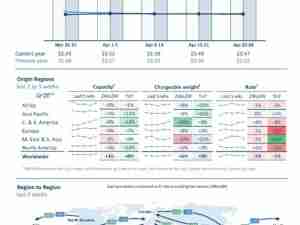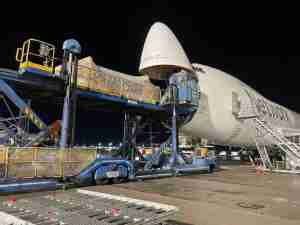Fitch Ratings has assigned a 'AA' rating to the Department of Airports of the City of Los Angeles' (the department) $738 million senior revenue bonds 2020 series A issued on behalf of the Los Angeles International Airport (LAX).
Fitch has also affirmed the following LAX obligations:
--Approximately $3.1 billion of senior revenue bonds at 'AA';
--Approximately $4.5 billion subordinate revenue bonds at 'AA-';
--Payment obligations related to the approximately $1.2 billion LAX Integrated Express Solutions (LINXS) automated people mover (APM) Project senior lien revenue bonds at 'A'.
The Rating Outlook is Stable.
RATING RATIONALE
The ratings reflect superior credit characteristics including a strong underlying air trade service area, significant operational activity of 44.2 million enplanements in fiscal 2019 supported by a diverse mix of domestic and foreign-flag carriers, favorable rate agreements with airlines and very strong financial metrics consistent with the 'AA' category.
The scale of the capital program is significant at $12.3 billion through 2025, and additional borrowings will be required to provide portions of the funding. While airline costs will be increasing, leverage and coverage metrics are projected to remain strong. Two public private partnerships (P3) related to landside access have reached financial close and are in early stages of works. Cost and execution risks could develop through the overall capital program process, but these concerns appear to be sufficiently mitigated by the airport's strong and resilient market position in the Los Angeles region and positive fiscal position.
KEY RATING DRIVERS
Large Gateway Airport: Revenue Risk - Volume: Stronger
Extremely strong market economics reflected LAX's status as the nation's largest origination and destination (O&D) airport as well as one of the largest U.S. international gateway airports. The airport benefits from a strong and well-developed diversity of domestic and foreign-flag air carriers. Passenger traffic and carrier expansion trends have been particularly favorable in recent years. While alternate airports are within the Los Angeles metropolitan area, growth constraints at competing facilities allow LAX to capture over 78% of all enplaned passengers, including nearly all of the international market.
Sound Rate Agreements: Revenue Risk - Price: Stronger
LAX's carrier rate agreements began in 2013 using compensatory methodologies and a successor agreement is in process for execution that would extend through 2032. Carriers have until April 2020 to sign, well ahead of the expiration of the current agreement period. While core rate setting terms are similar, certain additional features such as a minimum 1.40x coverage test under an extraordinary coverage protection charge, inclusive of debt service and capital available payments as well as, revenue sharing credits, all collectively enhancing the pricing framework for LAWA. Airline cost levels were $16.52 per enplanement for fiscal 2019, remaining moderate for an international gateway airport while similarly providing financial flexibility. Airline costs are projected to rise significantly to nearly $30 as the capital program reaches completion and costs are captured into the airline rate base.
LARGE-SCALE CAPITAL PROGRAM: Infrastructure Development/Renewal - Midrange
The airport is undertaking an ambitious $12.3 billion capital program (ending in fiscal 2025) with a focus on a new midfield concourse and access improvements as well as additional airfield and terminal projects. While recent projects have been delivered successfully, several of the landside infrastructure improvements have become more complex, including public private partnerships for projects related to a new car rental center and automated people mover system.
CONSERVATIVE CAPITAL STRUCTURE: Debt Structure: Stronger (senior); Midrange (subordinate/payment obligations)
All of the existing senior and subordinated long-term airport debt is in fixed-rate mode, thus minimizing the risk for fluctuations in debt interest costs. Future debt issues are expected to remain in this mode. Covenants for rates and additional borrowings are relatively standard for the sector while all of the debt service reserves are cash funded. The availability payments for the APM and consolidated car rental center (CONRAC) projects are bifurcated for the operating and capital components and structured to support the debt financing through final maturity tied to the projects.
FINANCIAL SUMMARY
Current financial metrics such as debt service coverage (Fitch adjusted 2.5x of total senior and subordinate debt) and liquidity remain solid at over 500 days cash on hand. Leverage is moderate at 5.7x (in fiscal 2019) on a net debt to cash flow available for debt service basis for all debt while debt to enplanements is competitive at about $160. As the full costs of the capital program, including as much as nearly $5 billion in future debt borrowings, are phased in over the next five years, the projected coverage and leverage ratios are projected to remain close to historically strong levels but could be pressured in the event the airport underperforms on traffic and revenues.
PEER GROUP
Comparable Fitch-rated peers include Massachusetts-Boston (AA/Stable) and San Francisco (SFO; A+/Stable) airports. Both are either international gateway or large-hub facilities with strong revenue risk profiles supported by large enplanement levels and competitive airline costs coupled with sound financial metrics. LAX has stronger coverage levels and lower leverage compared with SFO, but metrics are slightly weaker compared with Boston, which has a very low debt burden for a large hub airport enterprise.
RATING SENSITIVITIES
Developments That May, Individually or Collectively, Lead to Positive Rating Action:
--Positive rating action is unlikely in the near term in light of the size of the capital program underway with additional borrowings expected.
Developments That May, Individually or Collectively, Lead to Negative Rating Action:
--Material changes to the airport's current forecast to cost structure, cash reserve position, and/or additional indebtedness that leads to overall sustained leverage above 8x could negatively affect ratings.
TRANSACTION SUMMARY
The airport intends to issue approximately $738 million in senior revenue bonds for the refunding of existing bonds issued in 2010. Under current market conditions, the net present value and annual cashflow savings are substantial in excess of $200 million and averaging about $14 million, respectively. The senior bonds are expected to be fixed rate amortizing bonds through 2040.
CREDIT UPDATE
LAX continues to demonstrate industry-leading traffic and financial performance. As expected with an international passenger and cargo gateway airport, LAX is served by a diverse mix of more than 75 domestic and foreign-flag passenger carriers. Cargo operations also remain a strong component of aviation performance. The largest passenger carrier, American Airlines, accounted for just 19.2% of the airport's total enplanements in fiscal 2019. This level of diversity is a particular strength of the credit. Fiscal 2019 traffic levels, at 44.2 million enplanements, continued to climb 1.5% over the prior year, a slower rate than in previous years.
The first half of fiscal 2020 indicates relatively flat traffic levels when compared with the prior year with headwinds including softness in Mexican service, the loss of 737MAX usage by several airlines and the Corona virus effects to China flights. Some uncertainty remains on the duration for each of these situations; however, LAX has among the most diverse air service operations with the U.S. and globally.
LAX's latest capital improvement program (CIP) is significant in size with a current estimate of $12.3 billion. The CIP extends through 2025 and focuses heavily on terminal space expansion and redevelopment. Several of the largest projects underway include a new 15-gate midfield satellite concourse at a cost of approximately $1.7 billion as well as new airport access and car rental center projects, both using public-private partnership approaches. Considering the recent growth in traffic and services, capacity expansion and terminal modernization are important needs for LAX in order to be well positioned for further growth.
The landside access project consists of an automated people mover system with several stations located within the central terminal area and off-airport locations to connect to parking sites and regional transit facilities. The developer team is led by Fluor and Balfour Beatty, among other equity sponsors, and LAX will be obligated to make both milestone payments and availability payments during the construction and operating periods.
The CONRAC facility will also be delivered using a design-build-operate-finance-maintain approach with a three-party developer team called L.A. Gateway Partners. Financial close for this project was reached in December 2018 and assumes a combination of developer debt and equity, customer facility charge (CFC) secured special facility obligations, and CFC pay-go contributions.
Execution and cost risks are potential concerns given the intended application of projects to be managed by the airport, airline tenants and public-private partnerships. In Fitch's view, LAX has demonstrated a solid history of executing on its more recent capital plans while controlling costs at budgeted levels.
Capex for the entire program, which runs through 2025, are expected to be funded at approximately 60% with debt (including nearly $4.3 billion of future senior and subordinate bonds following the issuance of the series 2019F bonds) supplemented by LAX funds, grants, and passenger facility charge (PFC) and CFC pay-go receipts.
FINANCIAL ANALYSIS
LAX's financial performance has been largely stable with coverage of total debt service at 3.4x based on indenture-derived fiscal 2019 results. Fitch's calculation of coverage, treating PFC receipts as revenue rather than debt service offsets, generated a still healthy ratio of about 2.5x. Despite a rising gross debt balance, LAX's leverage metrics are consistent with the 'AA' category on a historical basis with net debt-to-cash flow available for debt service (CFADS) at approximately 5.7x in fiscal 2019. LAX's liquidity position is healthy based on a Fitch-calculated 530 days cash on hand.
The sponsor's latest traffic and financial forecasts, developed for the airport's series 2019F bond issuance, assume the full implementation of the $12.3 billion capital program. Fitch reviewed the underlying assumptions, including moderate traffic growth that averages 2.2% through 2026 coupled with operating revenues and expenses growing at 7.8% and 7.2%, respectively, to be applied as the Fitch base case. Under this scenario, CPE is expected to reach close to $30 by 2026 as debt costs are incorporated into the airline rate base. However, airline costs at these levels for an international gateway airport would not be a credit concern as other airports with expanding international services are seeing material increases in their respective airport costs. Leverage on an aggregate debt basis is also expected to ramp higher to an average 6.1x through the forecast period but is still consistent with the 'AA' category.
Considering the history of some traffic losses in past recessions, Fitch's rating case assumes a nominal 0.5% positive average traffic growth rate through 2026 by assuming a 5% reduction in 2021 followed by modest recovery in the later years. The results indicate that CPE levels will peak at about $33 while total debt service coverage levels remain 1.8x or higher when treating PFC receipts as revenue in lieu of debt service offsets. Airport leverage is expected to be modestly higher, averaging 6.4x, as compared with the Fitch base case.
Fitch also assessed the airport's overall coverage metrics, taking into account availability-pay capital payments for public-private partnership APM and CONRAC financings where such payments are expected to begin in fiscal 2023. Under both the base and rating cases, Fitch anticipates the overall coverage levels to remain in the 1.6x-1.7x range. This should allow for ample annual contributions for pay-go capital spending.
SECURITY
The senior lien bonds are secured by a pledge of net pledged revenues at Los Angeles International Airport. The subordinate lien bonds are secured by a pledge of net pledged revenues subordinate to the senior bonds. The airport expects to use both lien levels to address future capital developments.
ESG CONSIDERATIONS
Unless otherwise disclosed in this section, the highest level of ESG credit relevance is a score of 3 -ESG issues are credit neutral or have only a minimal credit impact on the entity, either due to their nature or the way in which they are being managed by the entity.









